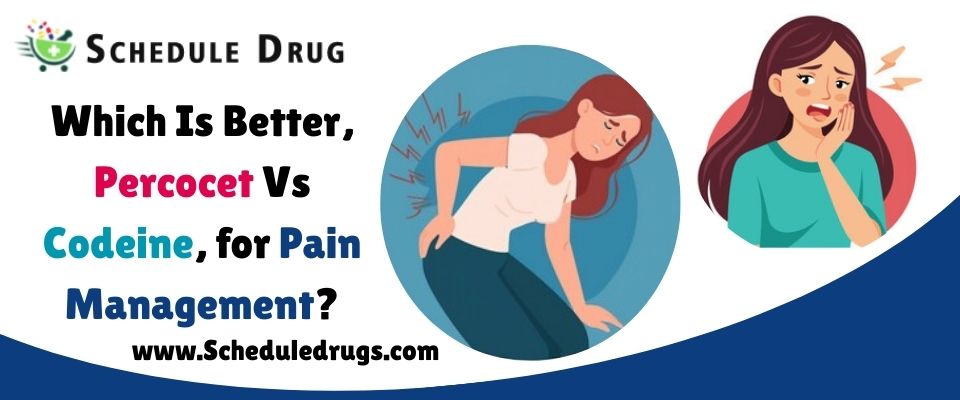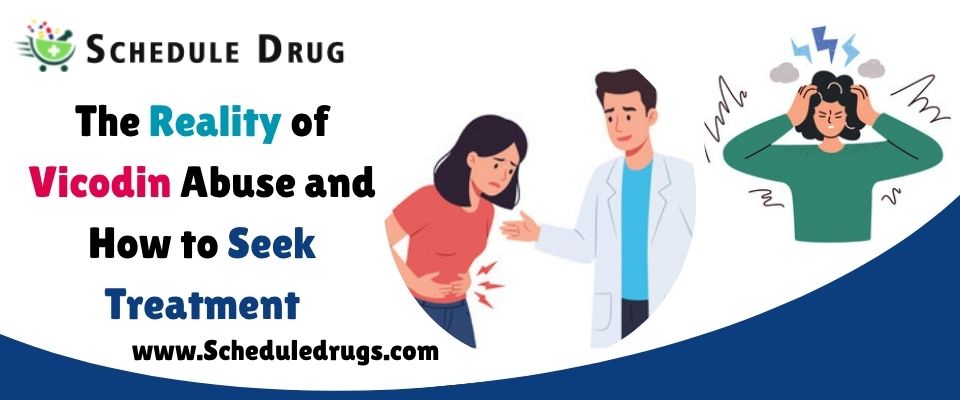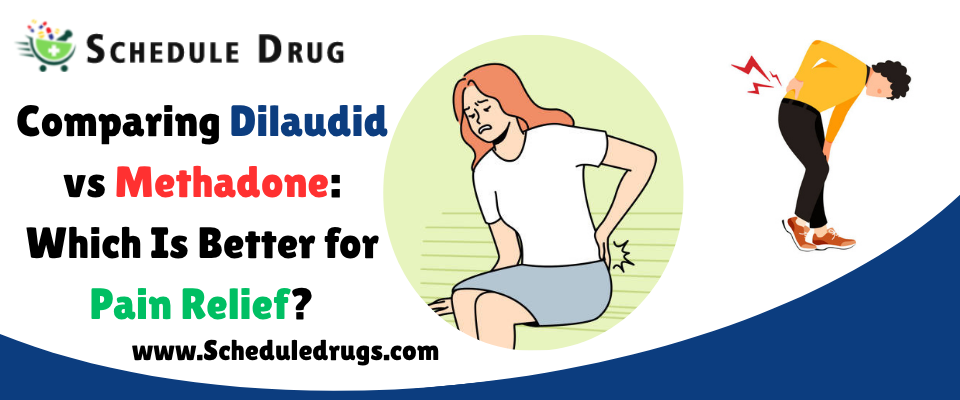Which Is Better, Percocet Vs Codeine, for Pain Management?
What Is Codeine?
Codeine is a prescription opioid medication often used to relieve mild to moderate pain and reduce coughing. Many people look for safe ways to buy codeine online when they cannot access it easily through local pharmacies. It’s important to understand its medical purpose before making any purchase.
Codeine is a prescription opioid medication that is primarily used to relieve mild to moderate pain and reduce coughing. It belongs to a class of drugs known as opioid analgesics, which work by binding to specific receptors in the brain and spinal cord to decrease the sensation of pain.
How Does Codeine Work?
Codeine works by affecting the central nervous system (CNS). It is an opioid analgesic, meaning it relieves pain by binding to opioid receptors in the brain and spinal cord. Once inside the body, codeine is partially converted into morphine, which is the compound that produces most of its pain-relieving and calming effects.
1. Conversion to Morphine
After ingestion, codeine is absorbed in the digestive system and metabolized by the liver enzyme CYP2D6.
A portion of codeine is converted into morphine, which is much stronger and more active.
The degree of conversion varies between individuals due to genetic differences.
Ultra-rapid metabolizers may convert more codeine into morphine, leading to stronger effects (and higher risk of side effects).
2. Binding to Opioid Receptors
Morphine (from codeine metabolism) binds to mu-opioid receptors in the brain, spinal cord, and gastrointestinal tract.
This binding reduces the transmission of pain signals between nerves, lowering the perception of pain.
In cough treatment, codeine also suppresses the cough reflex by acting on the medulla in the brainstem.
3. Effects on the Body
Pain Relief: Dulls pain perception and increases tolerance to pain.
Sedation: Produces calming or drowsy effects by slowing down brain activity.
Cough Suppression: Decreases activity in the cough center of the brain.
Side Effects: Can slow down breathing, cause constipation, dizziness, or nausea due to its action on the CNS and digestive system.
What Is Codeine Used For?
Codeine is a prescription opioid medication that has been widely used for decades in the treatment of pain and cough. Although it is considered a milder opioid compared to morphine or oxycodone, codeine is still a controlled substance because of its potential for misuse and dependence.
1. Pain Relief (Analgesic Use)
Mild to Moderate Pain: Codeine is often prescribed for short-term pain relief, such as pain after surgery, dental procedures, or minor injuries.
Combination Medications: It is commonly combined with non-opioid pain relievers such as:
Acetaminophen (Tylenol with codeine)
Aspirin with codeine These combinations increase effectiveness while reducing the need for high doses of codeine alone.
2. Cough Suppression (Antitussive Use)
Codeine can act directly on the cough center in the brain (medulla) to reduce the urge to cough.
It has been used in prescription cough syrups, particularly when cough is persistent and disruptive, such as in cases of:
Severe upper respiratory tract infections
Chronic lung conditions (though use is more limited now due to risks)
3. Diarrhea Treatment (Less Common Today)
In the past, codeine was sometimes used to manage severe diarrhea because it slows down bowel movements by acting on the gut.
Today, this use is rare, since safer alternatives exist with fewer risks.
What Forms of Codeine Are Available?
Codeine is available in several formulations and strengths, often combined with other medications to enhance effectiveness. The form prescribed depends on the condition being treated, patient age, and regional medical regulations.
1. Tablets and Capsules
Codeine Phosphate Tablets: Usually available in 15 mg, 30 mg, or 60 mg strengths.
Combination Tablets: Commonly combined with other pain relievers:
Codeine + Acetaminophen (Paracetamol): e.g., Tylenol with Codeine
Codeine + Aspirin: for pain and inflammation relief
Codeine + Ibuprofen: for stronger pain control
2. Syrups and Liquids
Cough Syrups Containing Codeine: Used to suppress persistent, dry cough by acting on the brain’s cough center.
May also include other ingredients such as guaifenesin (expectorant) or antihistamines.
Usually available only by prescription, though some countries once allowed low-dose codeine syrups over the counter (now heavily restricted in many regions due to misuse risks).
3. Injectable Form (Less Common)
In hospital or clinical settings, codeine may be given via intramuscular or subcutaneous injection.
Typically reserved for patients who cannot take oral medication or for post-surgical pain management.
What Is Percocet?
Percocet is a prescription medication commonly used to manage moderate to severe pain. Also known as an oxycodone-acetaminophen combination, it works by altering the way the brain perceives pain. Many patients rely on this medication for post-surgical recovery or chronic pain management.
Before you buy percocet online or explore online oxycodone sources, consult your doctor about dosage and potential side effects. Understanding your medical history and any other medications you take ensures safe use. Reading reviews of online pharmacies and checking for certification can protect you from scams.
How Does Percocet Work?
Percocet is a combination of oxycodone and acetaminophen, and each component works differently to relieve pain. Together, they provide more effective and longer-lasting pain relief than either would alone.
1. Oxycodone – The Opioid Component
Mechanism: Oxycodone is an opioid analgesic, meaning it binds to mu-opioid receptors in the brain and spinal cord.
Effect on Pain: By attaching to these receptors, oxycodone blocks pain signals from reaching the brain and alters the perception of pain, making it feel less intense.
Other Effects: It also produces sedation and a sense of euphoria, which is why it has a high potential for dependence and misuse.
2. Acetaminophen – The Non-Opioid Component
Mechanism: Acetaminophen works primarily in the central nervous system to reduce the production of pain-signaling chemicals called prostaglandins.
Effect on Pain: It helps lower pain perception and can also reduce fever.
Synergistic Effect: When combined with oxycodone, acetaminophen allows for effective pain relief at lower doses of oxycodone, which can reduce some opioid-related risks.
3. How the Combination Works
The opioid (oxycodone) targets the brain and spinal cord to block pain signals.
The acetaminophen enhances this effect by reducing inflammation-related pain in the central nervous system.
This combination provides strong, fast-acting, and sustained pain relief, which is why Percocet is often prescribed for moderate to severe pain, such as post-surgical pain or severe injury pain.
What Is Percocet Used For?
Percocet is a prescription medication that combines oxycodone (an opioid) and acetaminophen (a non-opioid pain reliever). It is primarily used for the treatment of moderate to severe pain. Because it contains a strong opioid, Percocet is typically reserved for situations where other pain relievers, such as acetaminophen or ibuprofen alone, are not strong enough.
1. Post-Surgical Pain
Commonly prescribed after surgeries such as:
Orthopedic procedures (e.g., joint replacements)
Dental surgeries (e.g., wisdom tooth extraction)
Abdominal or thoracic surgeries
Helps patients manage acute pain while recovering and prevents unnecessary suffering.
2. Injury-Related Pain
Used for severe pain resulting from:
Fractures or broken bones
Severe sprains or strains
Burns or trauma injuries
Percocet works quickly to reduce pain intensity, making daily activities more manageable during recovery.
What Forms of Percocet Are Available?
Percocet is a prescription medication that comes in several tablet forms, combining oxycodone and acetaminophen in different strengths. It is primarily an oral medication, and unlike some opioids, it is not available as an injectable or syrup for general use.
1. Immediate-Release Tablets
The most common form of Percocet.
Designed to release the medication quickly into the bloodstream for rapid pain relief.
Available in combinations such as:
Oxycodone 2.5 mg + Acetaminophen 325 mg
Oxycodone 5 mg + Acetaminophen 325 mg
Oxycodone 7.5 mg + Acetaminophen 325 mg
Oxycodone 10 mg + Acetaminophen 325 mg
Prescribed for short-term, moderate to severe pain, often post-surgery or after injury.
2. Combination Strengths for Individualized Dosing
The different strengths allow doctors to tailor pain management to the patient’s needs.
Lower doses may be prescribed for people with lower pain tolerance or higher risk of side effects.
Higher doses are reserved for patients with severe pain, under strict supervision.
3. Extended-Release Forms (Not Standard Percocet)
Standard Percocet is immediate-release, meaning it acts quickly but wears off faster.
Some oxycodone/acetaminophen formulations may have extended-release properties, but these are different brand names (e.g., Tylox) and require careful monitoring.
Extended-release forms are generally reserved for chronic pain and not for acute pain relief.
Comparison of Percocet and Codeine
Here’s a clear and concise table comparing Percocet and Codeine for your blog:
| Feature | Percocet | Codeine |
| Active Ingredients | Oxycodone + Acetaminophen | Codeine (sometimes combined with acetaminophen or aspirin) |
| Drug Class | Strong opioid (Schedule II) | Weak opioid (Schedule II/III depending on formulation) |
| Strength | Moderate to strong pain relief | Mild to moderate pain relief |
| Forms Available | Oral tablets (immediate-release) | Tablets, capsules, syrups, suppositories, injections |
| Common Uses | Moderate to severe pain (post-surgery, injury, chronic pain) | Mild to moderate pain, cough suppression, occasionally diarrhea |
| Onset of Action | ~20–30 minutes | ~30–60 minutes |
| Duration of Action | 4–6 hours | 4–6 hours |
| Risk of Dependence/Addiction | High | Moderate (lower than Percocet) |
| Common Side Effects | Drowsiness, nausea, constipation, liver damage (acetaminophen) | Drowsiness, nausea, constipation, respiratory depression in high doses |
| Prescription Requirement | Yes, strict Schedule II | Yes (OTC low-dose codeine in some regions, mostly prescription now) |
| Cough Suppressant Effect | Minimal | Yes, effective antitussive |
| Liver Risk | Yes, due to acetaminophen content | Moderate, especially in combination products with acetaminophen |
Similarities Between Codeine and Percocet
Although Codeine and Percocet differ in strength and common uses, they share several important characteristics because they are both opioid-based pain medications.
1. Both Are Opioid Analgesics
Both medications belong to the opioid class, meaning they act on opioid receptors in the brain and spinal cord to reduce the perception of pain.
They are effective for pain relief, though Percocet is generally stronger.
2. Prescription-Only Medications
Both are controlled substances due to the potential for abuse, dependence, and addiction.
Codeine is Schedule II or III depending on formulation and country; Percocet is Schedule II in most regions.
4. Similar Side Effects
Common opioid-related side effects occur with both medications:
Drowsiness or sedation
Nausea and vomiting
Constipation
Dizziness
Both carry risks of respiratory depression if taken in high doses or combined with other depressants.
Potency and Abuse Potential Comparison
Codeine and Percocet differ significantly in strength (potency) and the risk of abuse or dependence due to their opioid content. Understanding these differences is important for safe use and prescribing decisions.
1. Potency
| Feature | Codeine | Percocet |
| Opioid Strength | Weak opioid | Strong opioid |
| Pain Relief Level | Mild to moderate pain | Moderate to severe pain |
| Conversion to Morphine | About 10% metabolized into morphine | Oxycodone is more potent than morphine, giving stronger pain relief |
| Typical Prescription Situations | Minor injuries, mild pain, cough suppression | Post-surgical pain, severe injuries, chronic severe pain |
2. Abuse and Dependence Potential
| Feature | Codeine | Percocet |
| Addiction Risk | Moderate | High |
| Tolerance Development | Slower | Faster due to higher potency |
| Withdrawal Severity | Mild to moderate | Moderate to severe |
| Misuse Risk | Lower but possible | Higher, especially if used in larger doses or combined with alcohol/other drugs |
| Regulation | Schedule II/III depending on formulation | Schedule II in most countries (strictly controlled) |
How Long Does Codeine Remain in Your System?
Half-Life: Codeine has a half-life of about 3–4 hours, meaning it takes this long for half of the dose to be eliminated from the body.
Detection in Urine: Codeine can usually be detected in urine for 1–2 days after the last dose.
Detection in Blood: Codeine remains in the blood for about 12 hours.
Detection in Saliva: Up to 1–4 days, depending on dose and frequency of use.
Detection in Hair: Codeine can be detected in hair for up to 90 days.
Factors affecting how long codeine stays in the system:
Dosage and frequency of use
Metabolism rate (genetic differences affect how quickly codeine converts to morphine)
Age, liver function, and overall health
Medical Uses and Prescribing Considerations
Both Codeine and Percocet are prescription opioids, but they differ in strength, approved uses, and prescribing precautions. Understanding these differences is crucial for safe and effective pain management.
1. Medical Uses
Codeine:
Pain Relief: Mild to moderate pain, such as headaches, dental procedures, or minor injuries.
Cough Suppression: Effective as an antitussive for persistent or disruptive coughs.
Occasional Use for Diarrhea: Rarely prescribed today for severe diarrhea, replaced by safer alternatives.
Percocet:
Moderate to Severe Pain: Post-surgical pain, severe injury-related pain, or cancer-related pain when non-opioid medications are insufficient.
Combination Therapy: Oxycodone + acetaminophen allows effective pain relief at lower opioid doses.
2. Prescribing Considerations
Codeine:
Patient Age: Generally avoided in children under 12 due to risk of respiratory depression.
Genetic Factors: Some people metabolize codeine into morphine faster (ultra-rapid metabolizers), increasing risk of side effects.
Short-Term Use: Usually prescribed for a few days to prevent dependence.
Drug Interactions: Care with other CNS depressants, alcohol, and certain medications like SSRIs.
Percocet:
Stronger Opioid: Requires careful dosing and monitoring due to high abuse potential.
Liver Health: Acetaminophen content limits maximum daily dosage; patients with liver disease need special caution.
Short-Term vs. Chronic Use: Typically short-term for acute pain; long-term use is closely monitored due to risk of tolerance, dependence, and addiction.
Drug Interactions: Avoid combining with other opioids, alcohol, sedatives, or drugs affecting liver metabolism.
Side Effects and Risk
Codeine – Side Effects and Risks
Common Side Effects: Drowsiness, dizziness, nausea, constipation, dry mouth
Serious Risks: Respiratory depression, low blood pressure, allergic reactions
Dependence & Addiction: Risk increases with prolonged or high-dose use
Cough Suppression Risks: Can cause breathing problems in children or sensitive individuals
Other Considerations: May interact with alcohol, sedatives, or other CNS depressants
Percocet – Side Effects and Risks
Common Side Effects: Drowsiness, dizziness, nausea, constipation, headache
Serious Risks: Respiratory depression, liver damage (from acetaminophen), overdose
Dependence & Addiction: High risk due to strong opioid content
Drug Interactions: Dangerous when combined with alcohol, sedatives, or other opioids
Other Considerations: Requires careful monitoring in patients with liver disease or chronic conditions
Treatment and Recovery Options
Opioid medications like Codeine and Percocet are effective for pain but carry risks of dependence, misuse, and overdose. Treatment and recovery options focus on safe discontinuation, managing withdrawal, and long-term recovery.
1. Medical Supervision for Discontinuation
Gradual tapering is often necessary to prevent withdrawal symptoms.
Dose reduction schedules are tailored to:
Duration of opioid use
Strength of medication
Patient health and age
2. Withdrawal Management
Symptoms: Anxiety, sweating, nausea, muscle aches, insomnia, irritability.
Supportive Care: Hydration, nutrition, over-the-counter medications for minor symptoms.
Prescription Medications: Sometimes, buprenorphine, methadone, or clonidine may be used to ease withdrawal safely.
3. Behavioral and Psychological Support
Cognitive Behavioral Therapy (CBT): Helps patients identify triggers and develop coping strategies.
Counseling and Support Groups: Peer support or professional counseling reduces relapse risk.
Stress Management: Mindfulness, yoga, and relaxation techniques help manage cravings and mental health.
4. Alternative Pain Management
Non-Opioid Medications: Acetaminophen, NSAIDs (ibuprofen, naproxen) for mild to moderate pain.
Physical Therapy: Strengthening and mobility exercises to reduce chronic pain.
Complementary Therapies: Acupuncture, massage, and heat/cold therapy for pain relief.



